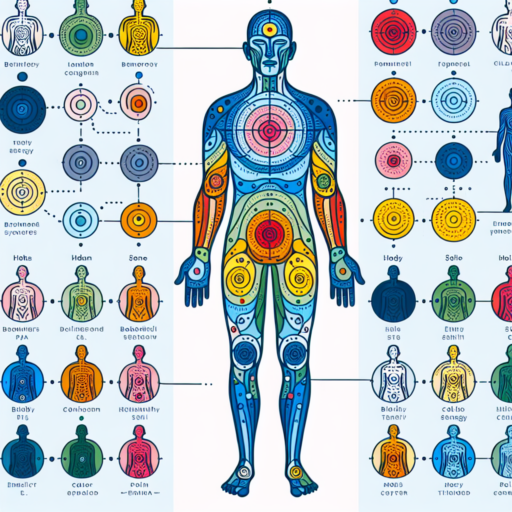Introduction to Color Zones of the Body
Understanding the concept of color zones of the body is fundamental for professionals across various disciplines, including artists, healthcare providers, and cosmetologists. These zones are critical in assessing physical health, creating realistic art, and applying proper makeup techniques. By studying the differing pigmentation and coloration across distinct body areas, individuals can gain insights into underlying conditions, enhance aesthetic appeal, and much more.
The body’s diverse color zones can range from the lighter shades found on the palms of the hands and soles of the feet to the richer, more pigmented areas like the face and back. Variability in these zones does not only stem from inherent genetic differences but is also significantly influenced by environmental exposure and health-related factors. The interplay between light and shadow, alongside the unique hues of each zone, plays a pivotal role in rendering realistic portrayals in the world of art and design.
For health professionals, an in-depth understanding of color zones assists in the early detection of diseases. For instance, a discoloration in certain body areas can be indicative of specific health issues. Artists, on the other hand, utilize this knowledge to enhance the lifelikeness of their work, focusing on how light interacts with different skin tones and textures. Similarly, cosmetologists might adjust makeup shades and techniques to complement or correct natural color variations, achieving a more balanced and harmonious look.
The Significance of Understanding Body Color Zones
An in-depth comprehension of body color zones not only enhances our basic understanding of human physiology but also provides crucial insights into our health and well-being. It’s a subject matter that might seem complex at first glance, yet, it holds vital importance for a range of professionals — from healthcare providers to beauty experts. As we unravel the layers of significance that these zones hold, it becomes evident how they can serve as a roadmap to our overall health status.
Body color zones, as a concept, extend beyond the superficial surface of the skin. They are essentially indicative of the myriad physiological processes taking place beneath. For instance, changes in skin coloration can be a telltale sign of underlying health conditions. A deeper understanding of these zones enables early detection of potential health issues, facilitating prompt intervention. Moreover, for individuals in the cosmetic and aesthetic industries, knowing how to read these signs can optimize the results of treatments and therapies, ensuring a holistic approach to beauty and wellness.
Engaging with the study of body color zones also empowers individuals to make informed decisions about their health and lifestyle. By recognizing the significance of these indicators, one can track changes over time, becoming more attuned to what their body is communicating through its most visible organ – the skin. This level of awareness is a pivotal step towards preventative healthcare, where proactive measures can be taken based on the subtle cues our bodies provide us through color variations in different zones.
Exploring the Different Color Zones of the Body
The human body is a canvas of varying hues and colors, each zone distinctively marked by its unique shade and significance. In the realm of health and wellness, understanding these color zones can be incredibly insightful. They are not just visual markers but can also be indicators of health, emotional states, and even personality traits according to some studies.
The Significance of Body Color Zones
Each color zone on the body is like a window into our internal health. For instance, a rosy complexion is often associated with good circulation and heart health, while yellowish tones might indicate liver or gallbladder issues. These color zones can vary widely among individuals, influenced by factors such as genetics, environmental exposure, and lifestyle choices. Recognizing these colors and their potential implications can guide individuals in maintaining or improving their health.
Key Body Color Zones
- Facial Colors: The face is one of the most revealing parts of the body when it comes to color zones. Changes in facial coloration can signal anything from emotional responses to deeper health issues.
- Extremities: The colors of our hands and feet also provide significant clues about our overall well-being. Pale extremities may suggest poor circulation, while a bluish tint may indicate respiratory or cardiovascular problems.
- Torso and Back: The torso and back areas hold critical information about internal organ function, with certain discolorations potentially pointing to underlying health conditions.
As we delve deeper into the exploration of body color zones, it’s essential to maintain a balanced perspective. These color variations can be normal for many individuals and do not always signify health issues. However, sudden or unexplained changes should be evaluated by a healthcare professional. Understanding the different color zones of the body empowers individuals to be more in tune with their health and well-being.
How Color Zones Can Indicate Health and Wellness
Understanding the concept of color zones in relation to health and wellness can transform the way we perceive our physical and mental wellbeing. These zones, represented by various colors, are not just symbolic; they offer a visual cue to the complexities of our health state, making it easier to monitor and manage over time. This unique approach can offer insights into how we react to stress, physical strain, and even dietary choices, shedding light on the deeper aspects of our wellness journey.
The Interpretation of Color Zones
Each color zone is associated with specific health and wellness indicators. For instance, a red zone might highlight areas of concern or immediate attention, such as high stress levels or potential overexertion, signaling the need for rest or medical intervention. On the other end of the spectrum, a green zone suggests a state of optimal health, where the body and mind are in harmony, indicating good physical fitness and mental resilience. Understanding these zones can aid in early detection of health issues, encouraging a proactive approach to health management.
Practical Applications in Daily Life
The application of color zones in daily life can range from personal wellness routines to professional health monitoring. For example, wearable technology now often incorporates color-coded feedback, giving users an immediate visual assessment of their wellness metrics, such as heart rate or sleep quality. Similarly, mental health apps might use color zones to help users gauge their stress or mood levels over time, offering a simple yet effective tool for emotional regulation and mindfulness. By paying attention to these color indicators, individuals can make informed decisions about their health and wellness routines.
Interpreting Color Changes in Body Zones
Understanding the nuances of color changes in various body zones can be a crucial indicator of both health and mood. These changes, often subtle, can signal a range of conditions, from simple emotional responses to more complex health issues. Being aware of what different color changes might mean is the first step in addressing potential concerns.
Common Causes of Color Changes
Several factors can cause the skin and other body zones to change color. For one, emotional shifts such as embarrassment or anger can lead to noticeable reddening of the cheeks due to increased blood flow. On the other hand, a lack of oxygen in the blood, possibly due to heart or lung conditions, can cause the skin or lips to take on a bluish tint. Environmental factors, including exposure to cold temperatures, might also result in temporary color changes, influencing the body’s attempt to regulate temperature.
Areas Most Affected by Color Changes
- Fingernails and toenails: Changes in color can indicate nutritional deficiencies or systemic health issues.
- Skin: General health can often be gauged by the skin’s color, with pallor suggesting anemia, yellowing pointing to liver dysfunction, and so forth.
- Eyes: The whites of the eyes turning yellow could signify jaundice, while redness may alert to eye infections or allergies.
Recognizing the significance of these changes requires a keen observation and, often, a professional diagnosis. While some shifts in coloration are benign or temporary, others may necessitate medical attention. Thus, becoming literate in the body’s visual signals can empower individuals to better manage their health and wellbeing.
Tips for Maintaining Healthy Color Zones
Maintaining healthy color zones in your landscape is crucial for both aesthetic appeal and plant health. These zones, classified based on light and moisture requirements, dictate how well your garden thrives. Understanding the nuances can make a significant difference in your gardening success. Here are practical tips to ensure these zones remain vibrant and healthy.
Assess and Optimize Soil Conditions
Each color zone flourishes in specific soil types. Performing a soil test can reveal much about what your plants need. For areas with highly vibrant zones, incorporating organic matter can improve soil structure and nutrient availability. Additionally, ensuring proper drainage will prevent waterlogging, crucial for maintaining root health.
Select Plants Carefully
It’s imperative to select plants that are appropriate for each color zone’s unique conditions. Use local plant guides or consult with a garden expert to choose species with compatible light, water, and soil requirements. Grouping plants with similar needs together not only simplifies maintenance but also enhances the overall visual impact of your garden.
Maintaining healthy color zones requires a balance of aesthetics and plant biology. By adjusting your gardening practices to accommodate the specific needs of each zone, you can create a more resilient and vibrant garden. Remember, the key to a thriving garden is not just about the initial setup but ongoing care and adaptation.
The Role of Diet and Lifestyle in Body Color Zones
Understanding the influence of diet and lifestyle on the distinct color zones of the human body is crucial in recognizing how our daily choices impact our overall health and appearance. These color zones, which refer to various areas of the skin that might differ in hue due to health and lifestyle factors, can significantly tell us about the body’s well-being and condition.
Influence of Diet on Skin Coloration
The saying «You are what you eat» holds particularly true when it comes to skin health. Consuming foods rich in antioxidants, such as fruits and vegetables, can protect the skin from oxidative damage, leading to a healthier complexion. For instance, the carotenoids in carrots and tomatoes can impart a natural, healthy glow to the skin, enhancing its coloration positively. Conversely, an excessive intake of processed foods and sugars is linked to a dull complexion and uneven skin tone, highlighting the critical role diet plays in affecting the body’s color zones.
Impact of Lifestyle Choices
Lifestyle choices, including exercise, sleep, and sun exposure, actively influence the body’s color zones. Regular physical activity enhances circulation, promoting a vibrant, more even skin tone. Adequate sleep is essential for skin regeneration, which can prevent dark circles and uneven color patches. Meanwhile, controlled sun exposure is necessary for vitamin D synthesis but excessive sunbathing can lead to hyperpigmentation and other skin color irregularities. Balancing these lifestyle factors is key to maintaining even and healthy skin color zones.
Moreover, habits such as smoking and alcohol consumption have been shown to have adverse effects on skin coloration. Smoking constricts blood vessels, leading to a lackluster complexion, while excessive alcohol intake can cause skin dehydration and flushes, further affecting the skin’s color uniformity and overall health.
Common Concerns with Body Color Changes
Experiencing changes in body color can be both confusing and concerning for many individuals. It’s not uncommon for people to notice variations in their skin tone, whether it manifests as spots, general discoloration, or sudden color changes in specific body parts. Understanding these changes is key to identifying potential health issues or reassuring oneself about natural bodily processes.
Factors Contributing to Body Color Changes
Several factors can lead to changes in body color. Exposure to the sun is a primary cause, often resulting in darker skin tones or the development of sunspots. Furthermore, certain medical conditions, such as jaundice or vitiligo, can cause significant color changes. It’s also important to consider lifestyle choices and their impact, including diet, medication, and personal hygiene habits. Recognizing these factors is crucial in addressing any underlying concerns effectively.
- Sun Exposure: Prolonged sun exposure can induce melanin production, leading to tanning or sunspots.
- Medical Conditions: Conditions like jaundice can cause the skin and eyes to yellow, while vitiligo may result in patches of skin losing their pigment.
- Lifestyle Choices: Certain medications, dietary habits, and hygiene practices can influence skin color and health.
While body color changes can often be benign, it’s essential to stay vigilant and seek professional advice if you notice abrupt or extensive changes. Early detection and understanding of the causes behind these changes can significantly aid in managing one’s health and well-being.
No se han encontrado productos.
When to Seek Medical Advice for Changes in Body Color Zones
Observing changes in the color of various body zones can often trigger alarm and raise questions about one’s health. It’s crucial to understand when these changes warrant a medical consultation, as they can be indicators of underlying health issues. Generally, a change in body color that is sudden, unexplained, or accompanied by other symptoms should prompt a visit to your healthcare provider.
Symptoms Accompanying Color Changes
Changes in body color zones can manifest alongside other symptoms, which might give more context about the underlying cause. For instance, if the discoloration is accompanied by fever, pain, swelling, or discomfort, it might indicate an infection or an inflammatory process. Similarly, persistent changes in skin color, such as darkening or redness that do not fade away, could be a sign of more serious conditions like diabetes or skin cancer. Paying attention to these accompanying symptoms can help determine the urgency of seeking medical advice.
Types of Color Changes and Their Implications
- Jaundice – Yellowing of the skin and eyes often associated with liver problems.
- Cyanosis – A bluish tint to the skin, indicating possible oxygenation issues.
- Erythema – Redness of the skin, which can be due to a variety of causes including infections, allergic reactions, or autoimmune conditions.
Identifying the specific type of color change can be useful in communicating your concerns to a healthcare provider. While some color changes might be benign, like those resulting from bruises that heal with time, others require prompt medical attention to address potential health risks.
Conclusion: Embracing the Diversity of Body Color Zones
In understanding and embracing the diversity of body color zones, we acknowledge a fundamental beauty in the human tapestry. The variations in skin tones across different parts of our bodies highlight a spectacular aspect of human biology that tells a story of evolution, genetics, and environmental adaptation. Recognizing that these differences are not flaws but rather facets of our individuality encourages a deeper appreciation for the natural world and for ourselves.
Diversity in body color zones can also serve as an educational tool, offering insights into how our bodies interact with the world. For example, areas that are more exposed to the sun may have darker pigmentation as a form of natural protection against UV rays. This adaptation underscores the incredible ways in which our bodies respond to our environment to protect us. By understanding these mechanisms, we can foster a more nurturing attitude towards our bodies, treating them with the care and respect they deserve.
Moreover, celebrating the diversity of body color zones can play a significant role in combating stereotypes and prejudices. It allows us to challenge societal standards of beauty that often overlook the richness of human diversity. By appreciating and valuing the myriad hues and tones our bodies exhibit, we contribute to a culture of inclusivity and respect for all. This shift in perception can pave the way for a more compassionate and understanding society, where everyone feels valued for their unique beauty.




